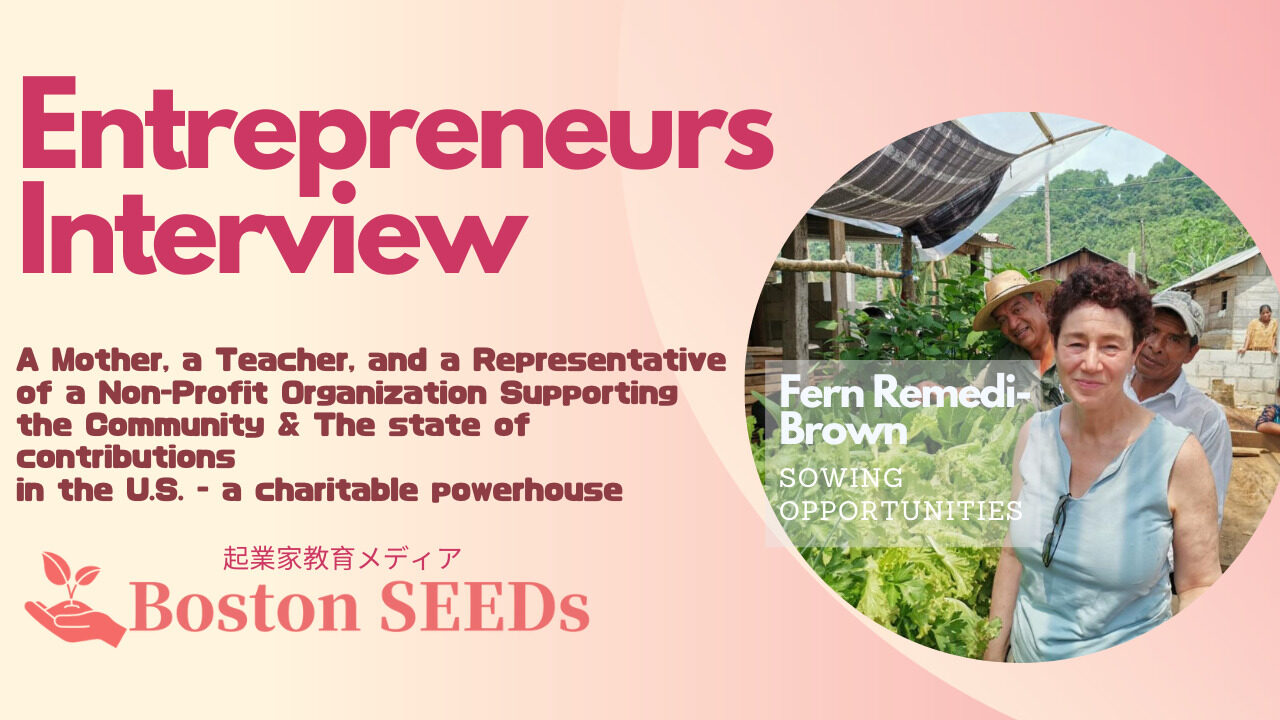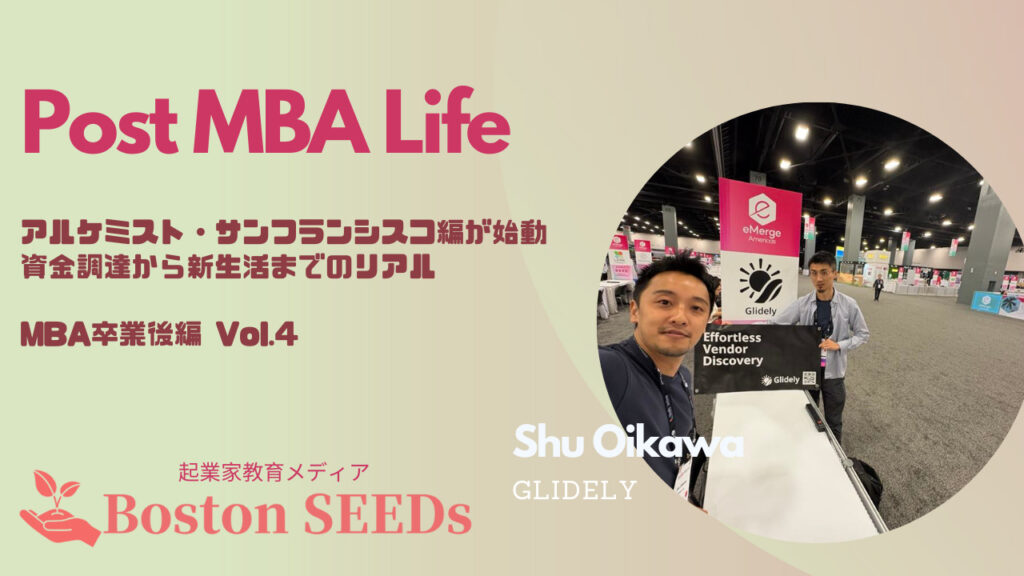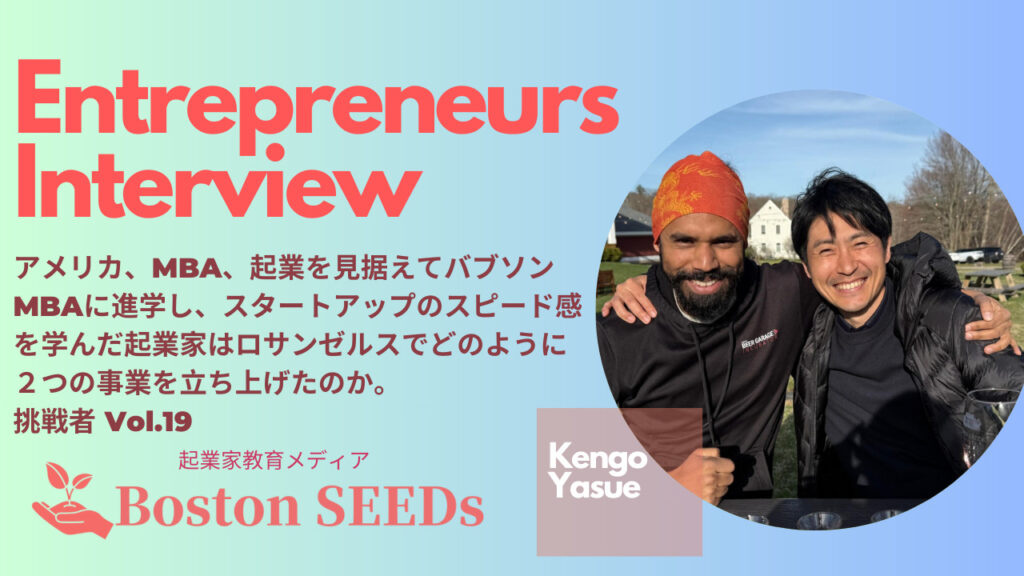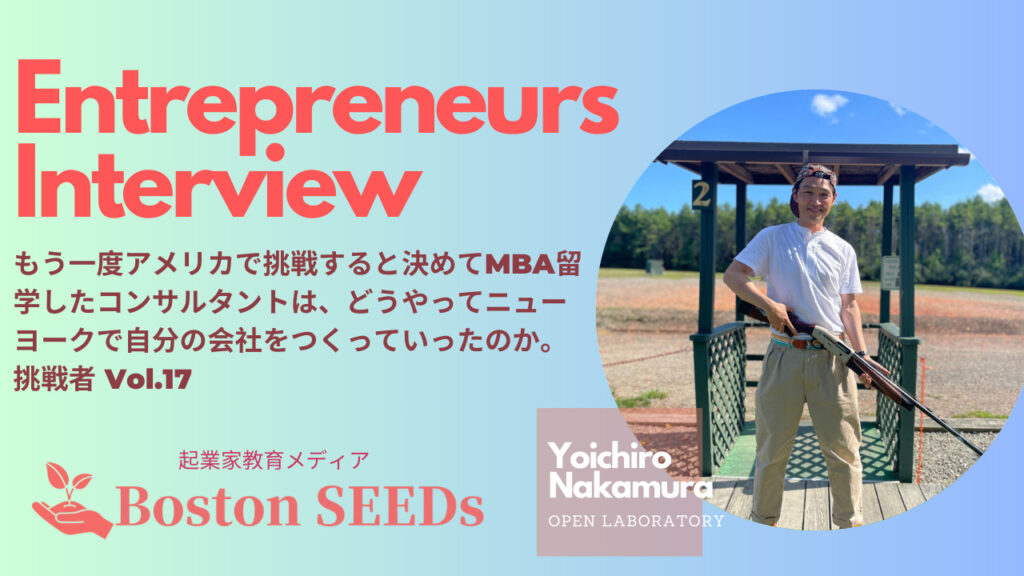*日本語記事はこちら*
What comes to mind when you hear the word “social contribution”? Volunteer work? One form of social contribution activity is the NPO (non-profit organization). In Japan, the “NPO (non-profit organization) Law” was enacted in 1998 with the aim of further promoting volunteer activities and other social contribution activities. Since then, the number of NPOs in Japan has steadily increased, and by the end of the year 2022, there were approximately 50,000 registered NPOs in Japan.
So who are the people who run NPOs? Are they special and different from ordinary citizens?
We had a rare opportunity to speak with Ms. Fern Remedi-Brown, a mother, a university teacher, and the president of “Sowing Opportunities,” a non-profit organization based in Massachusetts, USA, that supports remote, indigenous communities in Guatemala.
We wanted to hear about the current state of NPO activities in the U.S., as well as Ms. Fern’s motivation for starting NPO activities and her vision for the future.
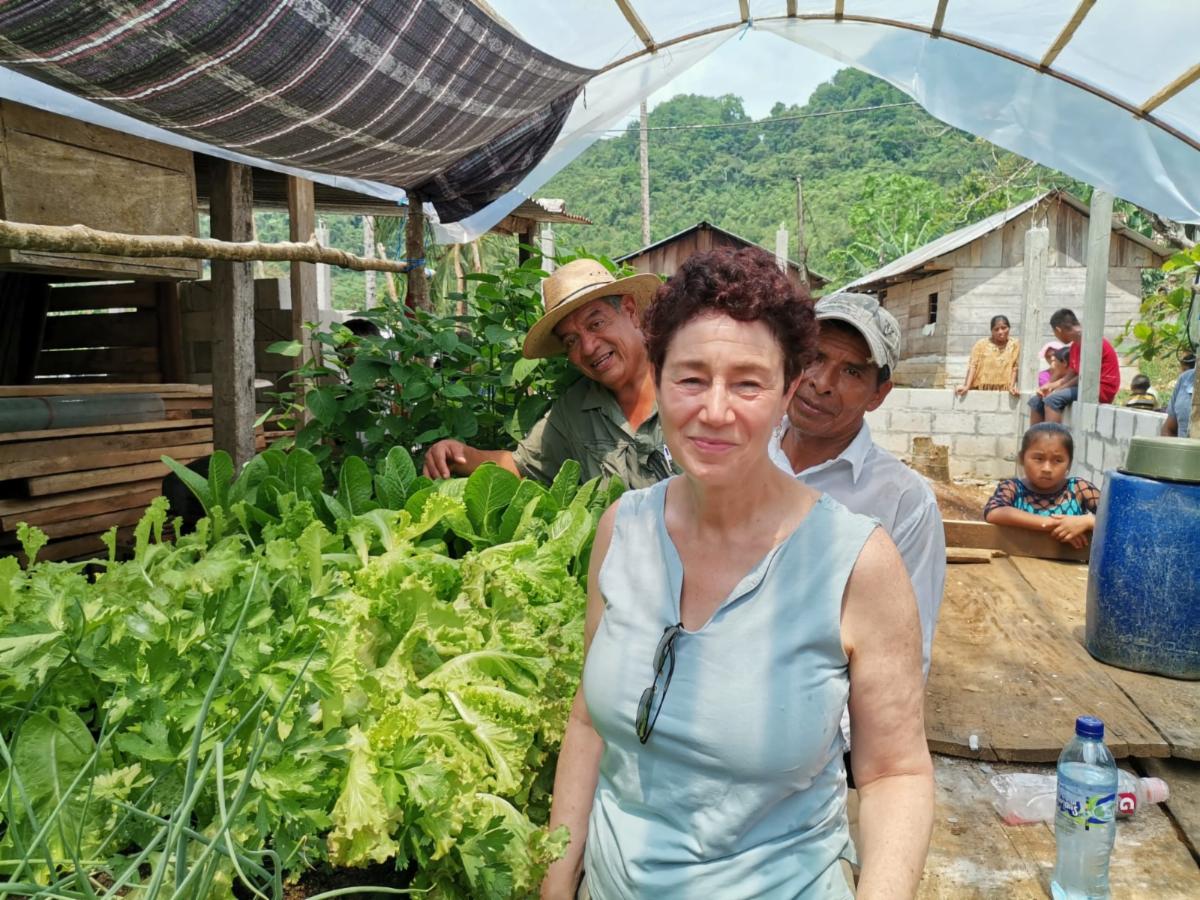
Ms. Fern Remedi-Brown
She is the founder of Sowing Opportunities, a non-profit organization based in Massachusetts, USA. She holds a Master’s degree in Education (English as a Second Language) and an MBA (Global & Healthcare Management), and has taught at Boston University and other educational institutions. She specializes in understanding the needs of multicultural and multilingual populations and designing successful programs, with projects focused on eliminating health care inequities worldwide. She has worked at Boston Children’s Hospital, Harvard School of Public Health, and as a freelance journalist, writing on global issues of social justice. For publications, see here.
The future is our own
Please tell us about your NPO activities.
I run a non-profit organization called “Sowing Opportunities,” which aims to provide the following solutions to indigenous Guatemalans based on the mission of “fostering self-reliance, education, and health in rural Guatemala.
- Agricultural cultivation systems through greenhouse farming and teaching families how to maintain them
- Providing knowledge for economic development and sustainable growth through the sale of agricultural products
- Installation of water access and filtration systems
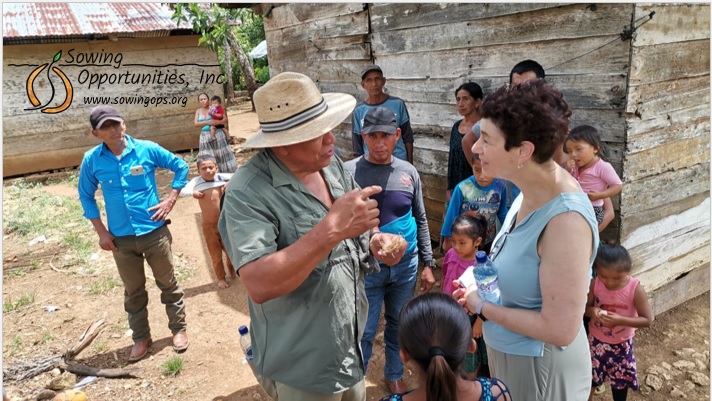
<She was speaking with their expert agricultural engineer who taught the participant families and actually lived in the remote village for 2½ months, from March to May 2022.>
Our main focus has been to build a greenhouse agricultural system, which will provide nourishment, and allow the participating families to sell their produce in local markets.
We began developing the concept in 2015 and registered the organization as a non-profit organization in 2018. By this time, we had conducted site visits, raised funds through crowdfunding, and gathered local partners.
In the U.S., to register as a non-profit organization, you must comply with the 501(c)(3) law, which requires that you have been active for a certain period of time before you can register as a non-profit organization. This is because donations to non-profit organizations in the U.S. are tax deductible This is why the federal government needs a certain period of time to review the application. In terms of typical time frames, the application for registration as a nonprofit organization can take anywhere from a few weeks to a few months, and the application for tax exemptions can take anywhere from a few months to a year. (Ref. How to Start a Nonprofit in 12 Steps)
Another reason for the delay in beginning our work was that I first needed to complete my MBA program. It was not easy to work full-time, attend an MBA program, and raise two small children.
Before I enrolled in the MBA program, I was working at a local hospital. At that time, I decided that I needed to further my professional development so I enrolled in an MBA.
One of my guiding principles, and one that is part of American culture, is “We can do anything. We can change the future.” I act on the idea that “We can change the future.”
What is the current status of NPOs in the U.S.?
Were you always familiar with NPOs?
In the process of continuing my own activities, I have accumulated more knowledge.
There are approximately 10 million (in 2021) registered NPO or NGO organizations worldwide, of which 20%, or 1.8 million, are based in the United States. (cf. FOUNDATION GROUP)
One area of resources that NPOs provide is in areas where the government does not provide services. An example is livelihood support for indigenous people. Another case where the government provides assistance but not enough of it is National Public Radio (NPR), the public radio station in the United States.
In addition, most of the funding that NPOs can obtain is for local communities (52%), and aid for international assistance is low at 10%, meaning that NPOs like ours that work across national borders need to work harder than usual. (cf. URBAN INSTITUTE)
Generally, when you hear the term NPO, what comes to mind is charity and other fundraising activities.
However, NPO activities can be broadly categorized into the following activities
– Fundraising for charity
– Connecting people with local communities
– Leading research activities
– Educating donors
– Assessing the needs of society
– Raising awareness
(cf. G2)
Funds for activities are raised by holding events and collecting donations, as well as through revenue – selling something that is either donated or created for sale.
Have you heard that the U.S. has a strong commitment to charity?
In addition to giving to others being part of the fabric of U.S. culture – originally through religious expectations – one reason is that donors can receive a tax deduction (tax break) for their donations.
In particular, the Tuesday after Thanksgiving (the end of November – a day called “Giving Tuesday”) as well as the period prior to New Year’s Day are the most popular times of the year to make donations. This is because on Giving Tuesday, many people want to give thanks to those around them by “paying it forward” (meaning, giving to others in appreciation for what you have), and before New Year’s Day, many people want to take advantage of the tax break because of the annual tax schedule (where people can reduce the amount they pay in taxes by making charitable donations).
The existence of my daughter motivated me
What motivated you to start an NPO to support Guatemala?
Actually, I did not intend to start an NPO at the beginning of my activities.
I have a daughter who was adopted from Guatemala, and in 2011, when she turned 6 years old, she told me she wanted to meet her biological mother. I was not hurt by her words. Because I too had never met my own father’s family, and I could relate to her feelings.
But as I mentioned earlier, I could not act immediately.
Four years later, in January 2015, with the help of a friend from Guatemala, I was able to look for our daughter’s biological mother. Fortunately, we were able to track her down.
When our friend’s contact shared what he had learned about our daughter’s biological mother, we recognized that the entire village was destitute and in need of help.
In June 2015, our family traveled to Guatemala and met our daughter’s biological mother in a tourist area far from the village. In December 2018, I was able to travel to the village and meet the inhabitants. I was very moved by this meeting, especially holding the hand of our daughter’s biological sister as we walked through the village. At that time, I witnessed the water tank, piping and faucets installed by the municipal government after our team met with the mayor in December 2017.
When I knew the severe conditions in which they were living, I felt that their lives would be in danger if nothing were done, and I believed that it was my mission to address this problem.
Since 2015 we have been trying to help this Guatemalan community to live independently, with the initial goal to improve the living conditions for the biological mother and her two children. But, witnessing the situation firsthand made it all that more vivid and immediate. My passion and commitment were secured at that moment.
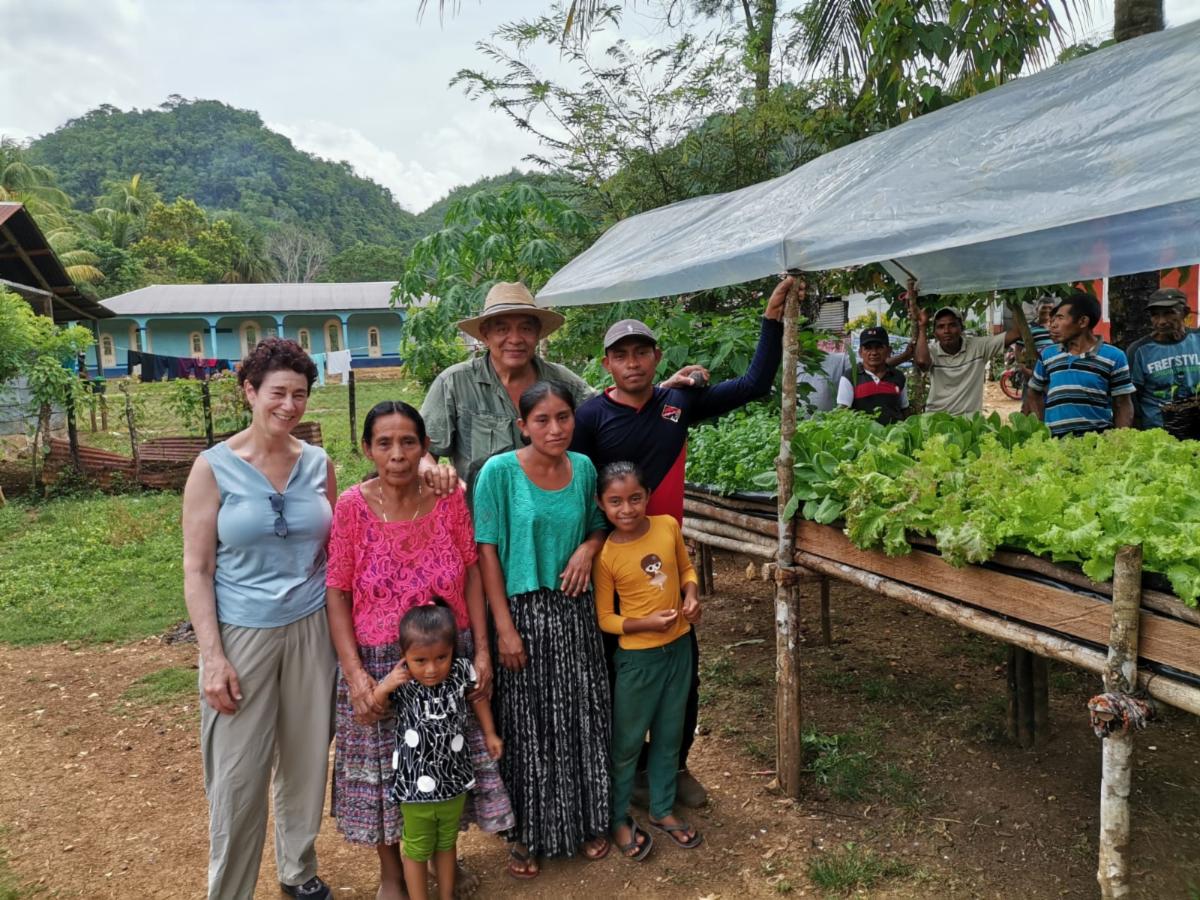
<She was standing at the greenhouse of one of the 30 participants families in the indigenous village of Chajmiac in the remote northeast sector of Guatemala in May 2022>
Proceed from what we can do and what is in front of us
What was the first action you took after deciding to support the project?
The first thing I did was crowdfunding (GoFundMe and Kickstarter); through these means, I was able to raise USD $40,000 in 2015 and 2016 through grassroots donations. However, it was not enough to support their community, and I began to think that in order to continue to provide authentic support, we would need to establish an organization such as a non-profit organization and obtain more funds on a more consistent basis.

At the time, however, we did not have any strong investors or supporters. So, we decided to call our friends and acquaintances one by one, creating a mailing list from their contact information that would regularly update them on our activities.
The mailing list we created at that time consisted of only 75 or so names, but it was a big step for us.
Initially we considered various options for agricultural projects, including tabasco chili peppers, chocolate, and other ideas.
We also made sure to understand the needs of the families in the village. In particular, we conducted interviews about what kind of crops they wanted to grow.
During these interviews, we purposely conducted them with men and women separately to avoid influencing each other’s opinions and to see what their individual needs were.
Based on their requests and the information provided by the agricultural experts, we finally decided to provide them with the resources to grow what is natively consumed – especially lettuce, celery, green onions, quilete [a green leafy vegetable native to Guatemala], and corn.
Driven by Passion
Were there any challenges in expanding your activities?
There were many challenges.
One was deciding what crops to grow.
Initially, we were considering growing tabasco chili peppers based on what can grow in the region, which is characterized by rocky, inarable soil. However, we realized that growing these crops would require a large investment of money, including buying or renting large tracts of land, and neither their assets nor the amount we could raise at the time would be sufficient to pay for this.
The next consideration was coffee bean production and also chocolate. However, due to geographical factors, we had to abandon the cultivation of these crops as well. We then realized that the best solution was what they natively use, especially corn and quilete, as mentioned above.
Without a decision on which crops to cultivate, none of the other actions could be taken, so the decision had to be made quickly.
The second consideration was COVID. Since we were no longer physically able to travel, we were mainly able to provide indirect support through our collaborators “on the ground.”
It was only recently (March 2022) that we started projects such as developing greenhouse cultivation. However, since we resumed support through in person visits to the area, we have been able to see remarkable results.
Another challenge is balancing my life.
I had to work a full-time job and raise two daughters while continuing this project.
No amount of time is enough for NPO activities. Therefore, we act in the bestway that we can in order to maximize the impact of our activities within the limited time we have to balance the rest of our lives. To do this, it is important to attract active board members and delegate to them as we operate.
I see my mission as transforming this remote village into a sustainable growing community. So even with these challenges, I am able to maintain my own motivation.
To expand the activities
What is the current goal?
To date, we have provided sustainable development measures to one rural village in the area and we began a second one in January 2023. Two other villages have expressed interest in our coming to help them with agricultural solutions. The inhabitants of the first village have requested improved systems for access to water, and we will be adding improved water filtration systems to this project through additional subprojects, as we are able to raise the funds.
We will also begin to improve the health of the community as a whole by providing health education through children’s nutrition and measuring their growth.
We will then purchase land for community housing and build homes in order to formally establish a local base of operations.
In order to move forward with these projects, we cannot expand our activities with traditional funding sources. By raising the profile of “Sowing Opportunities”, we aim to find new sponsors and promote the above activities.
To this end, we are engaged in media interviews and giving lectures.
For the future of Japan
Please give a message to those who are trying to realize social contribution activities in Japan.
Think about what is essential for your culture and take action for it.
For example, Japan is facing the issue of an aging society. In response to this issue, it is important for not only some specific people but also young people, such as high school and university students to participate in projects to solve problems and to think about preserving a valuable culture for the next generation.
The Japanese people have proven themselves through the test of time as having the strength to persevere in the face of adversity from outside forces, and also when others (both inside and outside of their country) have perceived them as different because of their race or background, as well as having the inner resilience to rebuild their world when it has crumbled around them.
So, I think that it is possible for Japanese to develop more interest in starting and supporting NPOs. I think it is possible for the Japanese people to do anything they set their minds to do!
We spoke with Ms.Fern, who founded a non-profit organization in the U.S. and is pursuing her passion in parallel with her work as a university lecturer and journalist. See also the 2022 activity report of “Sowing Opportunities” and an interview with a local media outlet.
投稿者
-

Boston SEEDs は B-SEEDs LLC (Delaware, US) 運営のオンラインメディアです。”Entrepreneurship Mindset”のカルチャーを世の中に更に浸透させるべく主にボストン在住の現役の MBA 生がボランティアで活動運営しています。 Note

